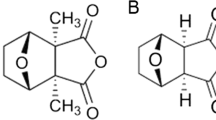Summary
Diethyldithiocarbamate (DDTC) and other dithiocarbamates are currently receiving attention as potential adjuncts to traditional chemotherapy. In vitro studies with rodent cancer cell lines have consistently shown that DDTC concentrations of 0.1–1.0μ g/ml are highly cytotoxic. Paradoxically, however, concentrations of 10–100 μg/ml have been significantly less toxic.
In the present study, such a ‘biphasic’ pattern was reproduced when 3 rodent cell lines were exposed for 1 hour to 0.001 to 1000 μg DDTC/ml. In contrast, in 7 human cell lines survival decreased steadily with increasing DDTC concentration (in the same dose range) without evidence of a biphasic pattern. These data might have implications for studies in which rodent cell lines are used to model the effects of dithiocarbamates in human tissues.
Similar content being viewed by others
References
Tempel K, Schmerold I, Goette A: The cytotoxic action of diethyldithiocarbamate in vitro Arzneim-Forsch 35:1052–1054, 1985
Powell AK: Effect of dithiocarbamates on sarcoma cells and fibrocytes cultured in vitro. British J Cancer 8:529–534, 1954
Rigas DA, Eginitis-Rigas C, Head C: Biphasic toxicity of diethyldithiocarbamate, a metal chelator, to T lymphocytes and polymorphonuclear granulocytes: reversal by zinc and copper. Biochem Biophys Res Commun 88:373–379, 1979
Renoux G, Renoux M, Lemarie E, Levandier M, Greco J, Bardos P, Lang JM, Boilleto A, Oberling F, Armand J, Mussett A, Biron G: Sodium diethyldithiocarbamate (Imuthiol) and cancer. In: Klein T, Specter S, Friedman H, Szentivanyi A (eds), Biological Response Modifiers in Human Oncology and Immunology. Plenum Press, New York, 1983, pp 223–239
Paredes J, Hong WK, Felder TB, Dimery IW, Choksi AJ, Newman RA, Castellanos AM, Robbins KT, McCarthy K, Atkinson N, Kramer AM, Hersh EM, Goepfert H: Prospective randomized trial of high-dose cisplatin and fluorouracil infusion with or without sodium diethyldithiocarbamate in recurrent and/or metastatic squamous cell carcinoma of the head and neck. J Clin Oncology 6:955–962, 1988
Bodenner DL, Dedon PC, Keng PC, Borch RF: Effect of diethyldithiocarbamate on cis-diamminedichloroplatinum (II)-induced cytotoxicity, DNA cross-linking, and glutamyl transpeptidae inhibition. Cancer Res 46:2745–2750, 1986
Hacker MP, Ershler WB, Newman RA, Gamelli RL: Effect of disulfiram (tetrathylthiuram disulide) and diethyldithiocarbamate on the bladder toxicity and antitumor activity of cyclophosphamide in mice. Cancer Res 42:4490–4494, 1982
Sladek NE, Landkamer GJ: Restoration of sensitivity to oxazaphosphorines by inhibitors of aldehyde dehydrogenase activity in cultured oxazahosphorine-resistant L1210 and cross-linking agent resistant P388 cell lines. Cancer Res 45:1549–1555, 1985
Lin PS, Kwock L, Goodchild NT: Copper chelator enhancement of bleomycin cytotoxicity. Cancer 46:2360–2364, 1980
Westman G, Midanders J: Post-irradiation diethyldithiocarbamate-inhibition of CuZn superoxide dismutase reduces clonogenic survival of Chinese hamster V79 cells. Int J Radiat Biol 45:11–20, 1984
Steward DJ, Verma S, Maroun JA: Phase I study of the combination of disulfiram with cisplatin. American J Clin Oncology 10:517–519, 1987
Freireich EJ, Gehan EA, Rall DP: Quantitative comparison of toxicity of anticancer agents in mouse, rat, hamster, dog, monkey and man. Cancer Chemotherapy Reports 50:219–244, 1966
Bodenner DL, Dedon PC, Keng PC, Katz JC, Borch RF: Selective protection against cis-diamminedichloroplatinum (II)-induced toxicity in kidney, gut, and bone marrow by diethyldithiocarbamate. Cancer Res 46:2751–2755, 1986
Evans RG, Nielsen J, Engel C, Wheatley C: Enhancement of heat sensitivity and modification of repair of potentially lethal heat damage in plateau-phase cultures of mammalian cells by diethyldithiocarbamate. Radiation Research 93: 319–325, 1983
Author information
Authors and Affiliations
Rights and permissions
About this article
Cite this article
Cohen, J.D., Robins, H.I. Cytotoxicity of diethyldithiocarbamate in human versus rodent cell lines. Invest New Drugs 8, 137–142 (1990). https://doi.org/10.1007/BF00177247
Issue Date:
DOI: https://doi.org/10.1007/BF00177247




